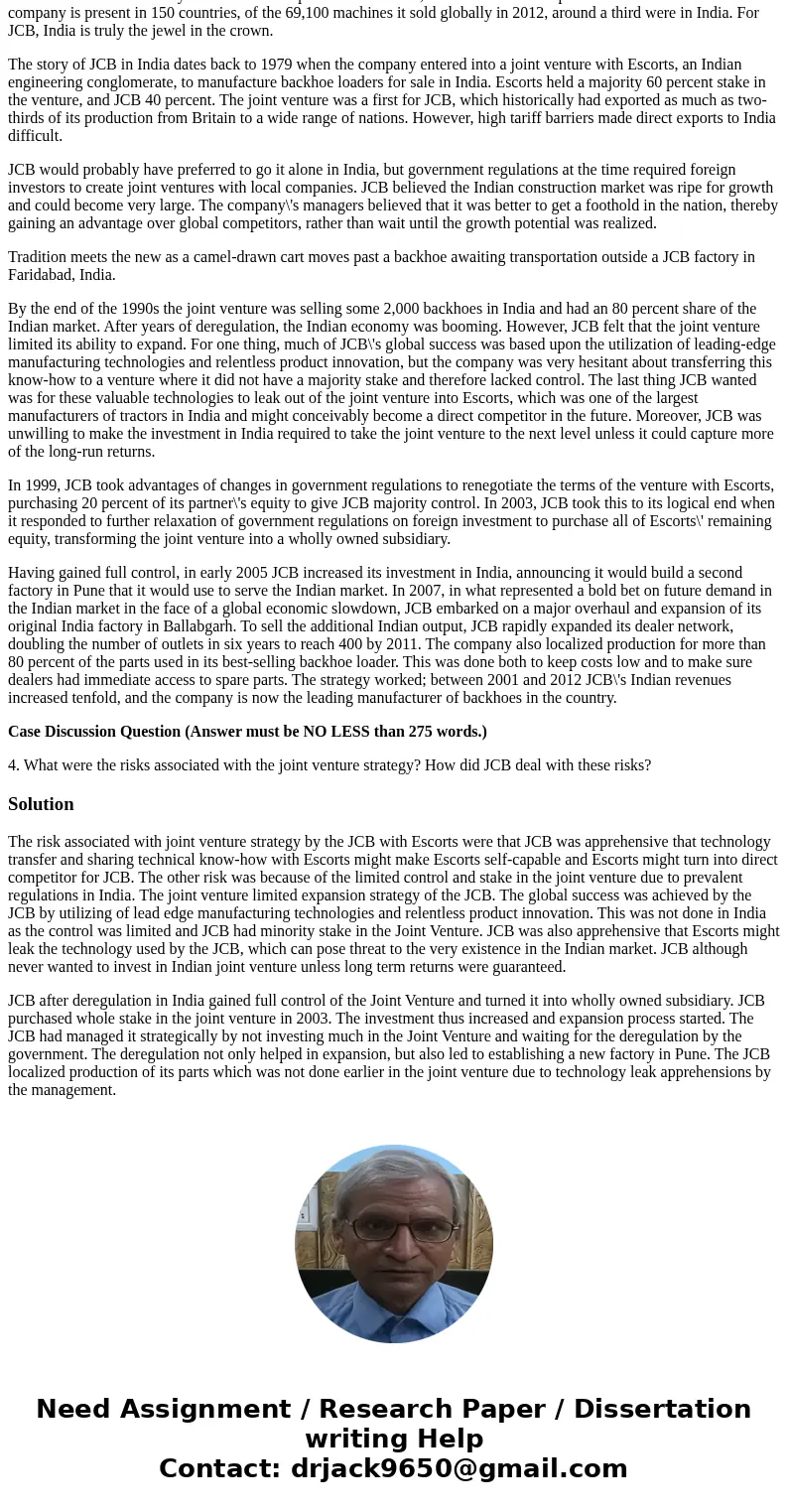JCB in India closing case Discussion question is below the a
JCB in India closing case (Discussion question is below the article.)
JCB, the venerable British manufacturer of construction equipment, has long been a relatively small player in a global market that is dominated by the likes of Caterpillar and Komatsu, but there is one exception to this: India. While the company is present in 150 countries, of the 69,100 machines it sold globally in 2012, around a third were in India. For JCB, India is truly the jewel in the crown.
The story of JCB in India dates back to 1979 when the company entered into a joint venture with Escorts, an Indian engineering conglomerate, to manufacture backhoe loaders for sale in India. Escorts held a majority 60 percent stake in the venture, and JCB 40 percent. The joint venture was a first for JCB, which historically had exported as much as two-thirds of its production from Britain to a wide range of nations. However, high tariff barriers made direct exports to India difficult.
JCB would probably have preferred to go it alone in India, but government regulations at the time required foreign investors to create joint ventures with local companies. JCB believed the Indian construction market was ripe for growth and could become very large. The company\'s managers believed that it was better to get a foothold in the nation, thereby gaining an advantage over global competitors, rather than wait until the growth potential was realized.
Tradition meets the new as a camel-drawn cart moves past a backhoe awaiting transportation outside a JCB factory in Faridabad, India.
By the end of the 1990s the joint venture was selling some 2,000 backhoes in India and had an 80 percent share of the Indian market. After years of deregulation, the Indian economy was booming. However, JCB felt that the joint venture limited its ability to expand. For one thing, much of JCB\'s global success was based upon the utilization of leading-edge manufacturing technologies and relentless product innovation, but the company was very hesitant about transferring this know-how to a venture where it did not have a majority stake and therefore lacked control. The last thing JCB wanted was for these valuable technologies to leak out of the joint venture into Escorts, which was one of the largest manufacturers of tractors in India and might conceivably become a direct competitor in the future. Moreover, JCB was unwilling to make the investment in India required to take the joint venture to the next level unless it could capture more of the long-run returns.
In 1999, JCB took advantages of changes in government regulations to renegotiate the terms of the venture with Escorts, purchasing 20 percent of its partner\'s equity to give JCB majority control. In 2003, JCB took this to its logical end when it responded to further relaxation of government regulations on foreign investment to purchase all of Escorts\' remaining equity, transforming the joint venture into a wholly owned subsidiary.
Having gained full control, in early 2005 JCB increased its investment in India, announcing it would build a second factory in Pune that it would use to serve the Indian market. In 2007, in what represented a bold bet on future demand in the Indian market in the face of a global economic slowdown, JCB embarked on a major overhaul and expansion of its original India factory in Ballabgarh. To sell the additional Indian output, JCB rapidly expanded its dealer network, doubling the number of outlets in six years to reach 400 by 2011. The company also localized production for more than 80 percent of the parts used in its best-selling backhoe loader. This was done both to keep costs low and to make sure dealers had immediate access to spare parts. The strategy worked; between 2001 and 2012 JCB\'s Indian revenues increased tenfold, and the company is now the leading manufacturer of backhoes in the country.
Case Discussion Question (Answer must be NO LESS than 275 words.)
4. What were the risks associated with the joint venture strategy? How did JCB deal with these risks?
Solution
The risk associated with joint venture strategy by the JCB with Escorts were that JCB was apprehensive that technology transfer and sharing technical know-how with Escorts might make Escorts self-capable and Escorts might turn into direct competitor for JCB. The other risk was because of the limited control and stake in the joint venture due to prevalent regulations in India. The joint venture limited expansion strategy of the JCB. The global success was achieved by the JCB by utilizing of lead edge manufacturing technologies and relentless product innovation. This was not done in India as the control was limited and JCB had minority stake in the Joint Venture. JCB was also apprehensive that Escorts might leak the technology used by the JCB, which can pose threat to the very existence in the Indian market. JCB although never wanted to invest in Indian joint venture unless long term returns were guaranteed.
JCB after deregulation in India gained full control of the Joint Venture and turned it into wholly owned subsidiary. JCB purchased whole stake in the joint venture in 2003. The investment thus increased and expansion process started. The JCB had managed it strategically by not investing much in the Joint Venture and waiting for the deregulation by the government. The deregulation not only helped in expansion, but also led to establishing a new factory in Pune. The JCB localized production of its parts which was not done earlier in the joint venture due to technology leak apprehensions by the management.


 Homework Sourse
Homework Sourse